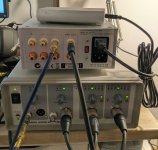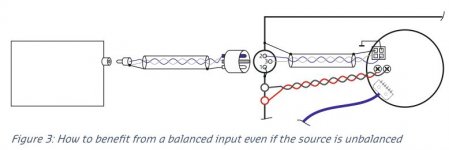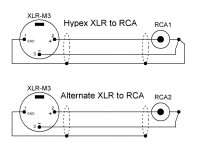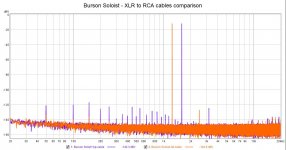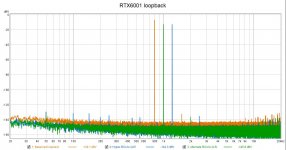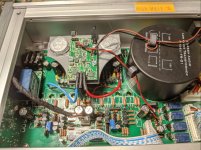I think... much closer that what you would expect, correct?
Probably, I will think it over, thanks.
Best wishes
David
LT makes excellent chips, but very few are suitable for audio. Audio has very special requirements that do not play a role in other areas of application.
LT makes excellent chips, but very few are suitable for audio. Audio has very special requirements that do not play a role in other areas of application.
Such as?
Appropriate marketing?
I find funny mentioning "audio suitability" in a thread dedicated to instrumentation. Does an instrument need to have a "sound" to be considered appropriate for audio measurements?
Actually there are real considerations for the audio market that are different other that the elusive "sound". SNR or dynamic range in the audio band. A weights noise. THD which is related but not identical to DNL or INL. At the same time adding a lot of overhead to using an ADC (external interface logic, filtering etc.) would need justification if the primary requirements are not substantially better. SAR ADC's have a lot of interesting applications and the separation of the sampling rate from basic function can be really helpful in specific applications but audio will have very constant predictable sample rates etc. and the additional flexibility is not a benefit.
Coming back to the line artefacts, power supply issue. Perhaps there is an additional source apart from the transformer stray.
I run into an issue where the line artefacts totally covered the interesting info from the DUT (pre-amp). I experimented with signal cabling and separate grounding cable, things got better but from a certain amplification level on things were just too bad ... until I switched to battery powering of the RTX.
Interestingly the issues did not vanish with battery power and power switch off (so transformer unpowered) until I unplugged the mains cable of the RTX.
One particular thing to mention here is that the RTX and the DUT were plugged in quite distant wall outlets (I could not change that).
Here the overlay of battery powered with and without mains cable plunged in.
The setup was single ended connection (urged by the DUT) but with recommanded Fig xxx cabling to the RTX and extra grounding connection.
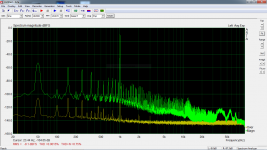
I run into an issue where the line artefacts totally covered the interesting info from the DUT (pre-amp). I experimented with signal cabling and separate grounding cable, things got better but from a certain amplification level on things were just too bad ... until I switched to battery powering of the RTX.
Interestingly the issues did not vanish with battery power and power switch off (so transformer unpowered) until I unplugged the mains cable of the RTX.
One particular thing to mention here is that the RTX and the DUT were plugged in quite distant wall outlets (I could not change that).
Here the overlay of battery powered with and without mains cable plunged in.
The setup was single ended connection (urged by the DUT) but with recommanded Fig xxx cabling to the RTX and extra grounding connection.

Working with ground loops can indeed be a challenge. Could you provide a bit more information about how the "Fig xxx cabling" was done?
Working with ground loops can indeed be a challenge. Could you provide a bit more information about how the "Fig xxx cabling" was done?
The DUT has Cinch in- and outputs. Connections were
RTX BNC-out to DUT in.
DUT out to RTX in with a cable where the lines coming from XLR pin 1,3 are connected in the cinch connector.
Moreover I connected the RTX dedicated ground point with the DUT dedicated ground point (provided for the good old turntable). But this had not much influence , if any.
Have you tried to use a resistor and capacitor when connecting to pin 1 as shown in the figure at the top of page 5 of this Application Note?
https://www.hypex.nl/img/upload/doc/an_wp/AN_Legacy_pin_1_problems.pdf
https://www.hypex.nl/img/upload/doc/an_wp/AN_Legacy_pin_1_problems.pdf
No. My primary goal was to troubleshoot the DUT not to explore ground loop issues. I was happy when I got a solution and continued with the main problem.
But I will keep in mind as a thing to try when I run in that again and have enough time not just to go the easy way with the battery.
But I will keep in mind as a thing to try when I run in that again and have enough time not just to go the easy way with the battery.
The DUT has Cinch in- and outputs. Connections were
RTX BNC-out to DUT in.
DUT out to RTX in with a cable where the lines coming from XLR pin 1,3 are connected in the cinch connector.
I'd connect the DUT output to the RTX input XLR pins 2/3 instead of 1/3, and leave pin 1 (shield/chassis) without a connection to the DUT. This breaks the ground loop from RTX chassis (BNC) --> DUT RCA in GND --> DUT RCA out GND --> RTX chassis (XLR pin 1).
Is the DUT chassis connected to mains earth (protective earth)? This might introduce another ground loop via the RTX connection to mains earth. Since the DUT and RTX are connected to different wall outlets, this might be a rather large ground loop. Maybe a ground loop breaker would help?
See here: Tutorial: How to use the RTX6001 audio analyzer in real world audio tests
Last edited:
Coming back to the line artefacts, power supply issue. Perhaps there is an additional source apart from the transformer stray.
I run into an issue where the line artefacts totally covered the interesting info from the DUT (pre-amp). I experimented with signal cabling and separate grounding cable, things got better but from a certain amplification level on things were just too bad ... until I switched to battery powering of the RTX.
Interestingly the issues did not vanish with battery power and power switch off (so transformer unpowered) until I unplugged the mains cable of the RTX.
One particular thing to mention here is that the RTX and the DUT were plugged in quite distant wall outlets (I could not change that).
Here the overlay of battery powered with and without mains cable plunged in.
The setup was single ended connection (urged by the DUT) but with recommanded Fig xxx cabling to the RTX and extra grounding connection.
View attachment 809370
So if it was there without mains power but not with mains power cable unplugged, that points to an issue with the mains power lead ground connection.
Jan
I don't think there is an "issue" as such. The problem is that the protective earth connection creates a ground loop, in this case probably a rather large one due to the "quite distant" wall outlets.
When the power cable is not in place, the ground loop is opened up, reducing issues with the ground currents.
When the power cable is not in place, the ground loop is opened up, reducing issues with the ground currents.
My thoughts on this are, is the RTX or the DUT having problems with the ground loop? And if it is could mostly be pinned down on the RTX side, could it be "hardened" against such influences.
Of cause one could argue there is no problem with a careful measurement setup, but it is also a question of convenience, after all the main goal is to analyze the DUT and not to create worry free measurement environments unless these are forced by the "law of physics".
Of cause one could argue there is no problem with a careful measurement setup, but it is also a question of convenience, after all the main goal is to analyze the DUT and not to create worry free measurement environments unless these are forced by the "law of physics".
In hindsight I should probably have added an unbalanced input option, with a circuit similar to the one in the Hypex app. note. But a simple adapter cable can be used to achieve the same function. Not quite as convenient, but hopefully not a huge problem either.
My thoughts on this are, is the RTX or the DUT having problems with the ground loop? And if it is could mostly be pinned down on the RTX side, could it be "hardened" against such influences.
Of cause one could argue there is no problem with a careful measurement setup, but it is also a question of convenience, after all the main goal is to analyze the DUT and not to create worry free measurement environments unless these are forced by the "law of physics".
I think all you need is a good understanding of ground loops, where they hide, and how to avoid them. The RTX wiki has a drawing and some hints that are useful.
If there is a ground loop via the protective earth connections of the RTX and the DUT, the DUT will likely also have the same ground loop problem with the DUT installed in its targeted environment. You might want to think about installing a ground loop breaker.
Some knowledge sharing related to same grounding topic.
I modified a Burson Soloist Headphone amp to use one of Jan Didden's SilentSwitchers. So now it can be powered from power-bank if one wants and get total ground isolation.
Yet when measuring I saw some 50Hz harmonics in spectrum... I was puzzled at first - how do I get those when the DUT device is powered from battery and thus it should not have ground loops.
After some experimentation I figured that I had been using a recommended wiring suggested in Hypex NC400 datasheet for XLR to RCA cable going into RTX6001 input, but one could wire the cable also differently as the second diagram shows below. In alternate case I've left the ground/screen of the cable unconnected on RCA end.
The difference it makes is clear... so depending on your DUT device and if it is unbalanced in/out then it might be worth to try both cable types.
I modified a Burson Soloist Headphone amp to use one of Jan Didden's SilentSwitchers. So now it can be powered from power-bank if one wants and get total ground isolation.
Yet when measuring I saw some 50Hz harmonics in spectrum... I was puzzled at first - how do I get those when the DUT device is powered from battery and thus it should not have ground loops.
After some experimentation I figured that I had been using a recommended wiring suggested in Hypex NC400 datasheet for XLR to RCA cable going into RTX6001 input, but one could wire the cable also differently as the second diagram shows below. In alternate case I've left the ground/screen of the cable unconnected on RCA end.
The difference it makes is clear... so depending on your DUT device and if it is unbalanced in/out then it might be worth to try both cable types.
Attachments
Yes, in the top level cabling there's a current running through the screen, that invites hum etc.
But you could also have made this change inside the enclosure shown with the Hypex round circuit, connect the screen One End Only, since the Hypex apparently already is connected to the chassis separately.
Jan
But you could also have made this change inside the enclosure shown with the Hypex round circuit, connect the screen One End Only, since the Hypex apparently already is connected to the chassis separately.
Jan
Last edited:
- Home
- Design & Build
- Equipment & Tools
- DIY Audio Analyzer with AK5397/AK5394A and AK4490
